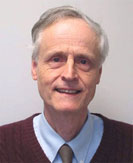 Alan Rogers (Photo courtesy of Alan Rogers)
Alan Rogers (Photo courtesy of Alan Rogers)
Alan Rogers
Article contributed by Helen Sim and Kenneth I, Kellermann
The 2010 Grote Reber Gold Medal for outstanding and innovative contributions to radio astronomy has been awarded to Dr. Alan Rogers, who is a Research Affiliate at the Massachusetts Institute of Technology Haystack Observatory. Rogers is being honored for his many pioneering developments in radio and radar interferometry, radio spectroscopy, and for his applications of radio astronomy techniques to society.
Rogers received his B.Sc. degrees in mathematics and physics from the University College of Rhodesia in 1962, and his S.M. and Ph.D degrees in Electrical Engineering from MIT in 1964 and 1967 respectively. Following a year as a Lecturer at the University of Zimbabwe in 1968, he has since been at the Haystack Observatory where he was the Associate Director until his retirement in 2006.
Rogers is best known for his contributions over many decades to the techniques of very long baseline interferometry. More recently, he developed an innovative radio array which he successfully used to detect the 327 MHz line of interstellar deuterium, capping a 40-year quest for this important astrophysical atomic gas. Currently, Rogers is searching for the low frequency signature characteristic of the cosmic epoch of reionization using a novel spectrometer which he has developed for this purpose. He was also the leader of a program to apply radio astronomy techniques to locate emergency calls from mobile telephones and he is currently conducting a program to monitor atmospheric ozone using inexpensive consumer satellite TV low noise amplifiers and dishes.
The 2010 Reber Medal will be presented to Alan Rogers in July 2010 in Hobart, Tasmania at the annual meeting of the Astronomical Society of Australia. The Reber Medal was established by the Trustees of the Grote Reber Foundation to honor the achievements of Grote Reber and is administered by the Queen Victoria Museum in Launceston, Tasmania.
Modified on Tuesday, 19-Jul-2011 15:14:07 EDT by Ellen Bouton, Archivist (Questions or feedback)
|
![[IAU logo]](iau_wb_thumb.jpg)
![[URSI logo]](URSI-logo-thumb.jpg)
![[Karl Jansky at his antenna]](jansky_photo_02_thumb.jpg)
![[Reber's Wheaton antenna]](Reber_Telescope_Wheaton_thumb.jpg)
![[Dover Heights]](Dover_Heights_02_thumb.jpg)
![[4C telescope]](GB61-195_4C_telescope_thumb.jpg)
![[Ewen and horn antenna]](ewen_horn1s.jpg)
![[Dwingeloo, 1956]](Dwingeloo-1956-thumb.jpg)
![[Jocelyn Bell Burnell and Cambridge antenna used in pulsar discovery]](burnell2_thumb.jpg)
![[Lovell Telescope at Jodrell Bank]](site_1594_0001-500-334-20180316163019-thumb150.jpg)
![[Wilson, Penzias, and Bell Labs horn antenna]](wilson-penzias-horn_thumb.jpg)
![[6-m Millimeter Radio Telescope in Mitaka, Japan]](6m-thumb.jpg)

